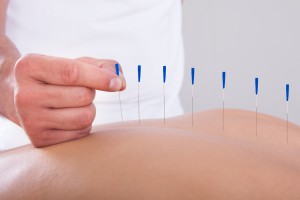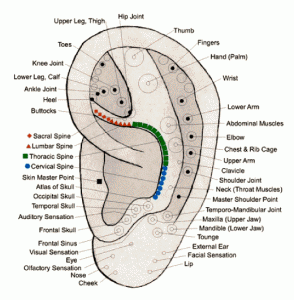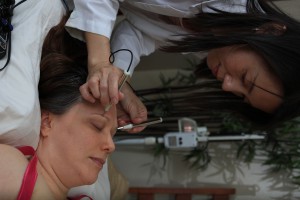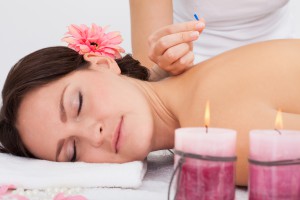What is Acupuncture?
Acupuncture is a complementary medical practice that entails stimulating certain points on the body, most often with a needle penetrating the skin, to alleviate pain or to help treat various health conditions. Medically speaking, acupuncture has been proven to:
- reduce inflammation & the perception of pain
- stimulate healing (immune response) in people with chronic illness
- improve mood, relieve stress & resolve feelings of anxiety
How It Works
Acupuncture has been endorsed for its health benefits by both Eastern Philosophy & Western Science.
Eastern Philosophy
 In traditional Chinese medicine, acupuncture is linked to the belief that disease is caused by disruptions to the flow of energy, or qi, in the body. Acupuncture stimulates points on or under the skin called acupuncture points or acupressure points, releasing this qi. The qi then travels through channels called meridians, to achieve equilibrium throughout the functions of your body.
In traditional Chinese medicine, acupuncture is linked to the belief that disease is caused by disruptions to the flow of energy, or qi, in the body. Acupuncture stimulates points on or under the skin called acupuncture points or acupressure points, releasing this qi. The qi then travels through channels called meridians, to achieve equilibrium throughout the functions of your body.Western Science
 Medical doctors refer their patients to acupuncture more than any other type of alternative medicine because it is a proven, safe and effective way to treat a wide variety of medical problems. While doctors may have competing ideas about “how” acupuncture works, one thing they agree on, is that it works.
Medical doctors refer their patients to acupuncture more than any other type of alternative medicine because it is a proven, safe and effective way to treat a wide variety of medical problems. While doctors may have competing ideas about “how” acupuncture works, one thing they agree on, is that it works.
Western scientists have been studying acupuncture for years to understand exactly why this treatment is effective for treating so many conditions. One major hypothesis is that acupuncture works through neurohormonal pathways. By stimulating the nerve, signals fire in the brain and the brain releases “happy” hormones resulting in a higher threshold for pain. Another hypothesis is that acupuncture works by reducing proteins that trigger inflammation, which is a leading cause of pain, Yet another hypothesis applies specifically to how acupuncture can be used to treat nerve damage, such as chemo-induced peripheral neuropathy, a condition that often causes numbness or weakness in the feet and hands. Filiform needles stimulate nerves that signal the brain to secrete nerve growth hormones that help nerves regenerate.
Types of Acupuncture
Regardless of the ailment that you hope to resolve with acupuncture, or the type of treatment that you prefer, all patients experience the same flat hourly rate. Request a free consultation and start your personal journey on the path to wellness, today.
Traditional Chinese Acupuncture
Auricular acupuncture is especially helpful for regulating your hormonal state. It is also widely used in weight control, addiction, smoke cessation, and anxiety.Auricular Acupuncture
 Auricular acupuncture is the stimulation of acupuncture points on the external ear surface for the diagnosis and treatment of health conditions in other areas of the body. The ear holds a microsystem of the body, consistent with the brain map discoveries of Canadian neuroscientist Wilder Penfield.
Auricular acupuncture is the stimulation of acupuncture points on the external ear surface for the diagnosis and treatment of health conditions in other areas of the body. The ear holds a microsystem of the body, consistent with the brain map discoveries of Canadian neuroscientist Wilder Penfield.
Scalp Acupuncture
Electro Acupuncture
 Acupuncture with electrical stimulation is the use of electrical current (micro amperage or milli-amperage) on the needles at the acupuncture site. It is used to increase effectiveness of the needles by continuous stimulation of the acupoint. Physiological effects (depending on location and settings) can include endorphin release for pain relief, reduction of inflammation, increased blood circulation, analgesia through interruption of pain stimulus, and muscle relaxation. It is indicated to treat chronic pain conditions, radiating pain along a nerve pathway, muscle spasm, inflammation, scar tissue pain, and pain located in multiple sites.
Acupuncture with electrical stimulation is the use of electrical current (micro amperage or milli-amperage) on the needles at the acupuncture site. It is used to increase effectiveness of the needles by continuous stimulation of the acupoint. Physiological effects (depending on location and settings) can include endorphin release for pain relief, reduction of inflammation, increased blood circulation, analgesia through interruption of pain stimulus, and muscle relaxation. It is indicated to treat chronic pain conditions, radiating pain along a nerve pathway, muscle spasm, inflammation, scar tissue pain, and pain located in multiple sites.Intradermal Acupuncture
Wrist/Ankle Acupuncture
Schedule an Appointment
 I always begin treatment with an extensive, personalized consultation, where we identify your specific needs and options. Acupuncture sessions last approximately 35“55 minutes, depending on the areas that you wish to have treated. Afterward, we may discuss further complementary treatment options based on your needs, schedule and lifestyle.
I always begin treatment with an extensive, personalized consultation, where we identify your specific needs and options. Acupuncture sessions last approximately 35“55 minutes, depending on the areas that you wish to have treated. Afterward, we may discuss further complementary treatment options based on your needs, schedule and lifestyle.
Regardless of the techniques we take advantage of during your visit, all of my services are performed at a flat rate of $80/hour. I appreciate the opportunity to help you, and I look forward finding the best solution for your very unique situation.
Contact me today to set up your free consultation.

